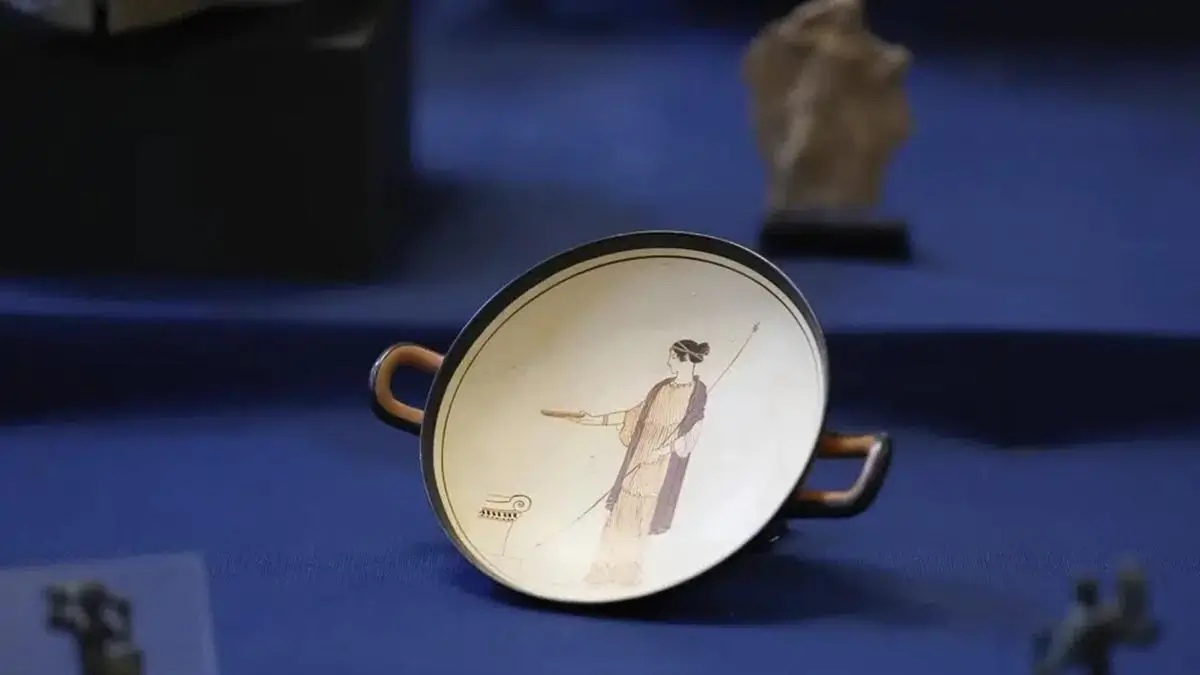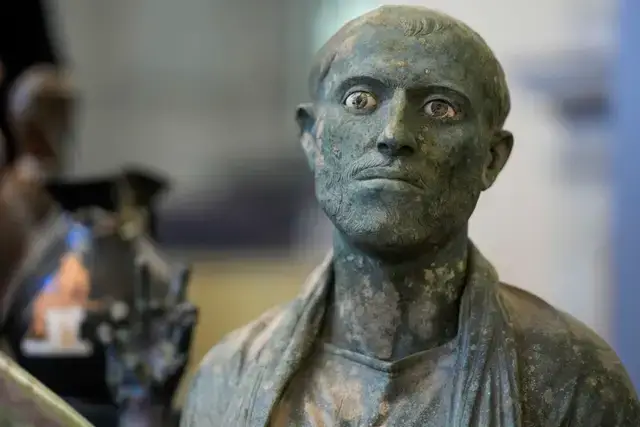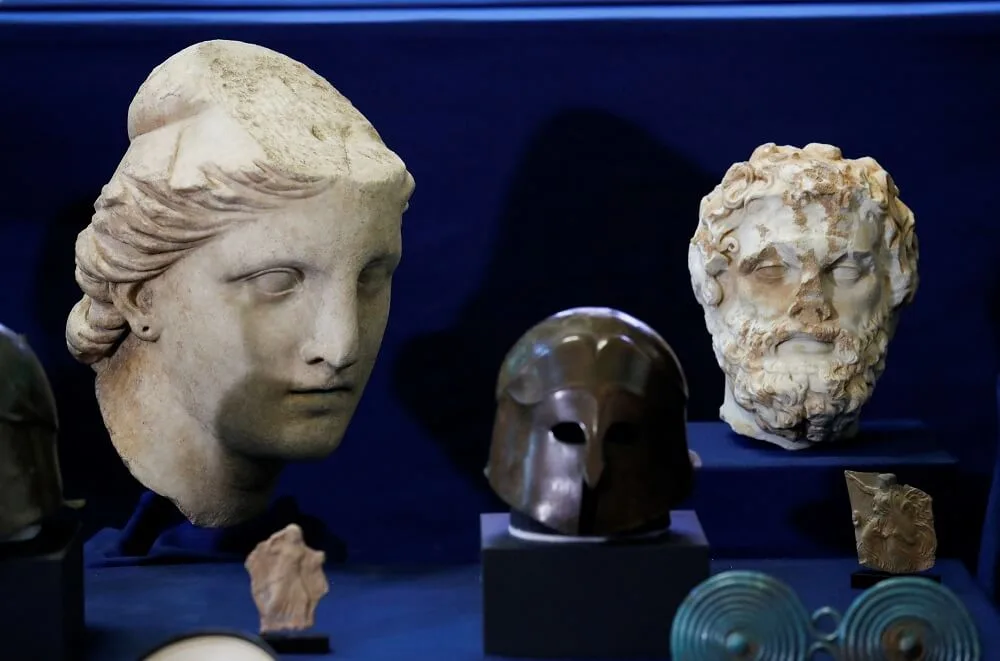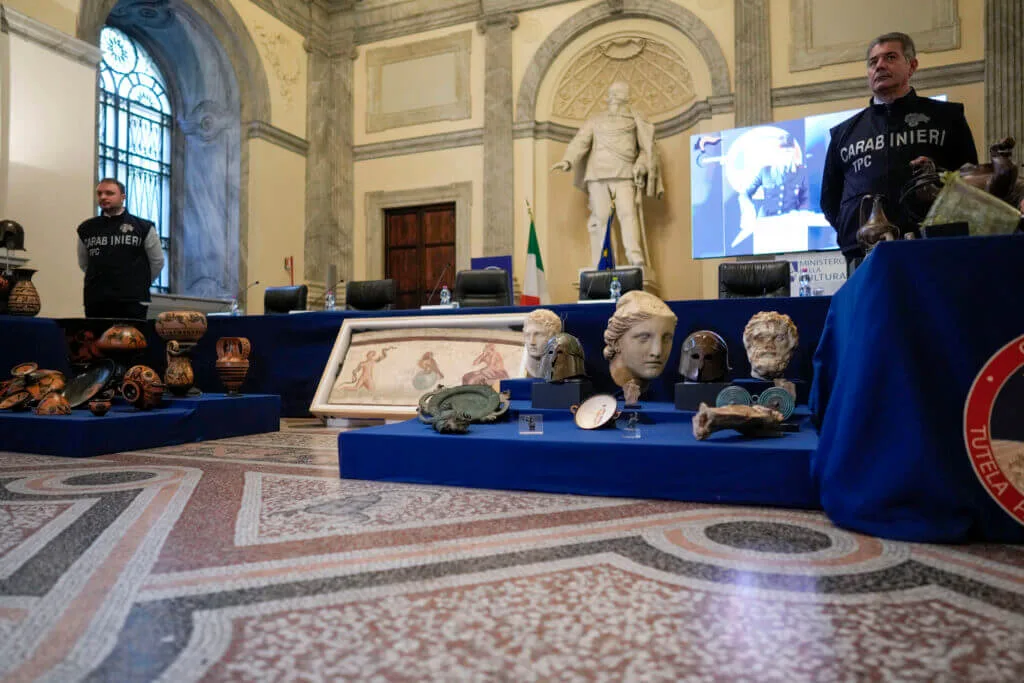Ancient Fresco Among 60 Treasures Returned to Italy From the US
A fresco portraying Hercules and initially from Herculaneum, a city obliterated alongside Pompeii by the 79AD ejection of Mount Vesuvius, is back in Italy, alongside 59 other old pieces illicitly dealt to the US.
The previous summer, US specialists declared that the fresco and many other dealt objects, which wound up in confidential assortments in the US, would return to Italy.
Among the more valuable pieces Italian and US authorities showed to writers in Rome is a BC kylix, or shallow two-dealt with a drinking vessel, precisely 2,600 years of age.
Likewise returned is an etched marble head from the second century BC, portraying the goddess Athena.
Archeological relics were taken from Italy and sold in the US by global workmanship dealers on show during a public interview in Rome (Andrew Medichini/AP)
Italy said the returned works are valued at in excess of 20 million bucks (£16 million) by and large.
The fresco, done in the exemplary style of Pompeiian workmanship, portrays Hercules as a kid choking a snake.
The returned pieces had been sold by craftsmanship sellers, wound up in confidential US assortments, and needed documentation to demonstrate they could be lawfully brought abroad from Italy.
Under a 1909 Italian regulation, archeological items exhumed in Italy can’t leave the country without consent except if they were taken abroad under the watchful eye of the law was made.
A kylix dish (Andrew Medichini/AP)
Among those at Monday’s show was Manhattan collaborator lead prosecutor Matthew Bogdanos, head of that office’s unit fighting illegal dealing with artifacts.
On this examination, his office worked together with a specific craftsmanship crew part of Italy’s paramilitary Carabinieri.
“For ancient Italian pieces alone, we have executed 75 strikes, recuperated in excess of 500 precious fortunes esteemed at in excess of 55 million bucks (£44 million),” Mr. Bogdanos said.
Italy has been a trailblazer in recovering unlawfully traded relics from historical centers and confidential assortments abroad.
A bronze male bust (Andrew Medichini/AP)
The nation has been so effective in recuperating such old works of art and curios that it made a historical center for them.
The Exhibition hall of Saved Workmanship was initiated in June with an enormous design that is essential for Rome’s old Showers of Diocletian.
Italian social specialists are choosing whether to allow the furthest down the line returned parts of exhibition halls close to where they were accepted to have been exhumed.
Culture serves Gennaro Sangiuliano let columnists know that one more chance is having an exceptional display of the brought pieces back.
A marble head of Athena (Andrew Medichini/AP)
Not just Italy loses bits of its own set of experiences when curios are found in surreptitious unearthings and snuck off to workmanship vendors for productive deals.
Scholastic specialists denied important data about the setting of the region where the articles were initially found, missing out on information about past civilizations.
Italy commended the arrival of 60 stolen from archeological curios worth more than $20 million, a significant number of which had been in plain view at New York’s Metropolitan Gallery of Craftsmanship before their illegal beginning was found.
The things, which U.S. specialists gave over to Italian partners in September, incorporate “The Marble Head of Athena,” worth an expected $3 million, and a fresco taken from Herculaneum, an old Roman city close to Pompeii.
Besides their business esteem, the recuperated fine arts are of “extremely valuable significance” for Italy’s notable, creative and social personality, the top of the Carabinieri police workmanship crew, General Vincenzo Molinese, said in a news gathering.
In September, the Manhattan Head prosecutor’s Office had said the ancient pieces had been sold by sentenced thieves, and some had wound up in the assortment of extremely rich person mutual funds chief Michael Steinhardt.
Italy definitely dislikes the plundering and sneaking of its creative and archeological legacy; however, the Carabinieri demand they are turning out to be more successful in finding and recuperating taken workmanship.
To feature their endeavors, a purported Gallery of Safeguarded Craftsmanship was initiated last year in Rome, showcasing many sculptures, containers, urns, plates, and coins in a segment of the Showers of Diocletian, when the Roman domain’s biggest spa.
The US on Tuesday authoritatively returned 25 relics that had been stolen from over the course of a long time from Italy, including Etruscan containers, first-century frescoes, and valuable books that wound up in U.S. historical centers, colleges, and confidential assortments.
Italy has been on a mission to recuperate steals from curios, utilizing the courts and public disgracing to propel historical centers and gatherers to return relics, and has won back a few significant pieces.
The things were either unexpectedly gone over to U.S. specialists or were seized by police after examiners saw them in Christie’s and Sotheby’s sale lists, display postings, or because of customs look legal disputes or tips. One seventeenth-century Venetian standard was seized by Boston line watch specialists as it was being carried from Egypt to the U.S. inside development hardware, police said.
U.S. Minister John Phillips joined Italy’s carabinieri workmanship police to flaunt the take. It included Etruscan containers from the Toledo Exhibition hall of Craftsmanship and the Minneapolis Organization of Workmanship, seventeenth-century herbal science books from Johns Hopkins College in Baltimore, and an original copy from the 1500s taken from the Turin archdiocese in 1990 that wound up recorded in the College of South Florida’s exceptional assortments.
“Italy is honored with a rich social inheritance and hence reviled to experience the plundering of significant social curios,” Phillips said, adding that Interpol gauges the unlawful exchange social legacy delivers more than $9 billion in benefits every year.
Police expressed a few of the things were supposedly sold by Italian vendors Giacomo Medici and Gianfranco Becchina, both sentenced for dealing with pillaged Roman relics. After the items were recuperated, Italian specialists affirmed their provenance.
Police focused on that most gatherers and historical centers readily surrendered their curios in the wake of learning they had been taken. The Minneapolis exhibition hall chief reached the Italian culture service subsequent to perusing an article around one suspect piece, police said.
Phillips applauded the cooperation between Italy’s police and U.S. Country Security and line watch specialists. He likewise said the U.S. had returned in excess of 7,600 items to more than 30 nations and unfamiliar residents starting around 2007.
Very nearly 200 stolen Greek and Roman curios that were seized from a New York City exhibition hall were localized to Italy last week after a thorough examination that elaborated the infamous Michael Steinhardt, a previous speculative stock investments director.
Also read, President Biden visits EL Paso Border to see Migrant Crisis
The greater part of them had shown up at the Fordham Gallery of Greek, Etruscan, and Roman Craftsmanship civility of Edoardo Almagia, a charged artifacts bootlegger from Italy.
The crowd, esteemed at an unimaginable $10 million, was localized under an arrangement that was the biggest ever such activity throughout the entire existence of the country of Italy.
Manhattan Head prosecutor Cy Vance, Jr. declared the arrival of the relics to individuals of Italy during a bringing home service went to by Italy Emissary General Fabrizio Di Michele, Italian Carabinieri Brigadier General Roberto Riccardi, and U.S. Country Security Examinations (“HSI”) Representative Specialist in Control Erik Rosenblatt.
Vance expressed, “For a really long time, esteemed exhibition halls and confidential gatherers across the US noticeably showed these verifiable Italian fortunes despite the fact that their very presence in America comprised proof of social legacy violations.
“The bringing home of this astonishing assortment of antiquated workmanship starts to address a portion of the harm done by dealers and shows the requirement for all gatherers and display proprietors to perform a reasonable level of investment and guarantee pieces they bought were legally procured.
“I’m regarded to return these 200 parts of individuals of Italy – our biggest such exchange of ancient pieces to this famous country. I thank my Office’s Relics Dealing Unit and our accomplices at Country Security Examinations for their eminent endeavors that have brought about in excess of 700 fortunes being gotten back to 14 nations since August 2020.”
Only weeks prior, Vance was liable for the understanding under which Steinhardt surrendered a sum of 47 stolen from relics to Greece.
Steinhardt has likewise acknowledged a lifetime restriction from gathering relics as a feature of the supplication understanding made with the Manhattan Head prosecutor’s office.
The ancient pieces Fresco Among 60 Treasures Returned to Italy From the US
from Steinhardt’s assortment that will be gotten back to Greece are from the Cycladic Islands, Crete, Focal Greece, Samos, and Rhodes. They incorporate various bronze blades, dolls, a Minoan sanctuary, a bronze griffin bust, and a kouros sculpture.
The mutual funds’ titan and giver’s assortment of almost 200 extremely valuable artifacts from somewhere around 11 nations, including Greece, Egypt, Iraq, Turkey, and Syria, merits an astonishing $70 million.
The greater part of the Fordham plunder was given to them by blamed relics runner Edoardo Alga, notwithstanding; he is currently at large somewhere in Italy, the Italian specialists accept.
HSI New York Appointee Specialist in Control Erik Rosenblatt had cruel words for every one of the people who attack the social legacy of nations and pirate them abroad. “The coordinated thieves and runners of illegal ancient rarities and artifacts are not interested in what ‘precious’ signifies and proceed to loot and take advantage of the world’s social legacy for benefit,” he expressed to correspondents.
Like the Steinhardt examination, which included archeological break master Christos Tsirogiannis, the Fordham examination included a committed gathering who were entrusted with ferreting out the provenance of each item.
Paleohistory News Organization reports that Italian Delegate General Fabrizio Di Michele expressed, “It is a wellspring of extraordinary fulfillment to see long stretches of two-sided participation between the Italian and American specialists, and prominently between the Manhattan Lead prosecutor’s Office, the Country Security Examinations, and the Carabinieri, bringing about the re-visitation of Italy of many valuable ancient pieces, going back as soon as to 2500 years B.C.”
Among the items returned last week as a feature of the stole from Greek and Roman curios, 150 were seized as a component of the examination by New York City inhabitant Edoardo Almagia, who is himself a local of Italy.
The Manhattan D.A. Relics Dealing Unit, made by Vance quite a while back, started examining Almagia quite a long while prior to dealing with old workmanship, selling it out of his own exhibition and condo in New York. The Relics dealing Unit worked close by alongside policing at HSI.
As most dealers do, Almagia utilized various tombaroli (“burial place bandits”) to plunder and pirate curios from everywhere in his local nation, including the southern and focal areas, alongside Sicily and Sardinia.
Much more stunningly, Almagia used an “organization of researchers, chiefs, and caretakers of the main worldwide galleries” to track down homes for his taken items, as per a specialist’s discoveries that were acknowledged by a court in Italy. Up until this point, the D.A. Office and HSI have finished 18 separate captures of 160 relics that have been dealt with by Almagia.
This incorporates ten pieces taken before in December from craftsmanship authority Michael Steinhardt, which will be en route to Italy soon.
Court reports documented in the criminal terrific jury examination of Steinhardt portray Almagia as a fastidious record guardian, keeping a record marked the “Green Book,” in which he recorded a considerable lot of the articles he sold, the cost he paid tombola for each piece, the cost he got for it, and even at times, the name to whom he sold the relic.
On occasion, the record expresses that he even gave clients careful subtleties of continuous surreptitious, clearly unlawful unearthings.
Past charges against Almagia for relics robbery were dropped due to the legal time limit.
The directing adjudicator portrayed Almagia as “contribut[ing] to what was one of the best sacks of Italian social legacy, in view of the sheer measure of taken merchandise” and added that he and his co-schemers have “torn pages from the book of Italian history.” Almagia stays on the loose in Italy.
One stole from an object to be localized, a krater enlivened by the man known as the Baltimore Painter, traces all the way back to 330 B.C. furthermore, it is esteemed at $100,000, a fifth Century B.C. Hydria, with a worth of $150,000, and a pathos portraying Ulysses, tracing all the way back to the seventh Century B.C., esteemed at $200,000, are likewise important for the goods held onto in the examination.






